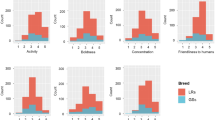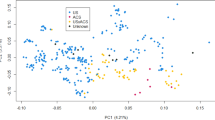Abstract
Dogs (Canis familiaris) have been around humans for 12,000 years or more. Genetic background or external environment allow many dog breeds to be trained to perform highly specialized tasks such as detecting drugs and guiding visually impaired people. In this study, we selected 50 Sapsaree dogs, a Korean breed that has the potential as a working dog. They underwent training and were scored during the in-training examination; given their scores, they were divided into pass or fail groups. We analyzed genetic difference between pass and fail individuals using genotyping of 13 microsatellite loci. The mean number of alleles, allelic richness, and observed heterozygosity of the pass group were 4.077, 4.061, and 0.489, respectively, whereas those of the fail group were 4.154, 4.138, and 0.465, respectively. Using the genetic information, we constructed statistical modeling. The results of both logistic regression analysis and decision tree indicated that the superiority of Sapsaree was determined by 166 repeats of bases (166 allele) and 164 repeats (164 allele) at TAT locus and 198 repeats (198 allele) of DRPLA gene. The results presented herein indicate that these allelic differences between the pass and fail group can be a good biomarker for selection of superior Sapsaree individuals, and our statistical modeling could provide the standard for selection of working dogs.



Similar content being viewed by others
References
Agresti A (1996) An introduction to categorical data analysis, vol 135. Wiley, New York
Cantor RM, Lange K, Sinsheimer JS (2010) Prioritizing GWAS results: a review of statistical methods and recommendations for their application. Am J Hum Genet 86:6–22
Cha SH, Tappert C (2009) A genetic algorithm for constructing compact binary decision trees. J Pattern Recognit Res 4:1–13
Cole M (2007) Phylogeny and cultural history in ontogeny. J Physiol 101:236–246
Coppinger R, Scheider R (1995) Evolution of working dogs. In: Serpell J (ed) The Domestic Dogs: its evolution, behavior and interactions with people. Cambridge University Press, Cambridge, pp 21–50
Duverle DA, Kawasaki S, Yamada Y, Sakuma J, Tsuda K (2015). Privacy-preserving statistical analysis by Exact Logistic Regression. 10.1109/SPW.2015.14
Ellegren H (2004) Microsatellte: simple sequences with complex evolution. Nat Rev Genet 5:435–445
Goudet J (2002) FSTAT, a program to estimate and test gene diversities and fixation indices (version 2.9.3.2). Available from http://www2.unil.ch/popgen/softwares/fstat.htm
Ha JH, Kim KS (1998) A review on the origin of Korean native dogs. Korean J Anim Sci 40:701–710
Han KI, Alam M, Lee YM, Le DH, Ha JH, Kim JJ (2010) A study on morphology and behavior of the Sapsaree: a Korean native dog (Canis Familiairs). JAST 52:481–490
Kalinowski ST, Taper ML, Marshall TC (2007) Revising how the computer program CERVUS accommodates genotyping error increases success in paternity assignment. Mol Ecol 16:1099–1106
Kim KS, Tanabe Y, Park CK, Ha JH (2001) Genetic variability in East Asian Dogs using microsatellite loci analysis. J Hered 92:398–403
Kim K, Sung J, Chang S, Yoon T (2015) Analysis of DFNA5′s three distinct mutations by Apriori, decision tree. 10.1109/35021BIGCOMP.2015.7072853
Kroll TL, Houpt KA, Hollis N (2004) The use of novel stimuli as indicators of aggressive behavior in dogs. J Amer Anim Hosp Assoc 40:13–19
Kwon YJ, Choi BH, Eo JW, Kim CR, Jung YD, Lee JR, Cho YR, Gim JA, Lee DH, Ha JH et al (2014) Genetic structure and variability of the working dog inferred from microsatellite marker analysis. Genes Genom 36:197–203
Leberg PL (2002) Estimating allelic richness: effects of sample size and bottlenecks. Mol Ecol 11:2445–2449
Levinson G, Gutman GA (1987) High frequencies of short frameshifts in poly-CA/TG tandem repeats borne by bacteriophage M13 in Escherichia coli K-12. Nucl Acids Res 15:5323–5338
Mirkin SM (2007) Expandable DNA repeats and human disease. Nature 447:932–940
Overall K, Hamilton S, Chang M (2006) Understanding the genetic basis of canine anxiety: phenotyping dogs for behavioral, neurochemical, and genetic assessment. J Vet Behav: Clin Appl Res 1:124–141
Petit RJ, Mousadik AE, Pons O (1998) Identifying populations for conservation on the basis of genetic markers. Conserv Biol 12:844–855
Ruczinski I, Kooperberg C, LeBlanc M (2003) Logic regression. J Comput Graph Stat 12:475–511
Schlotterer C, Tautz D (1992) Slippage synthesis of simple sequence DNA. Nucl Acids Res 20:211–215
Taylor K, Mills D (2006) The development and assessment of temperament tests for adult companion dogs. J Vet Behav 1:94–108
Turnbell PF, Reed CA (1974) The fauna from the terminal Pleistocene of Pale gawra cave, a Zarzian occupation site in northeastern Iraq. Fieldiana Anthropol 63:81–146
Valsecchi P, Barnard S, Stefanini C, Normando S (2011) Temperament test for re-homed dogs validated through direct behavioral observation in shelter and home environment. J Vet Behav 6:161–171
Acknowledgments
This research was supported by funding provided by the AGENDA project (Project No. PJ009254) from the National Institute of Animal Science, Rural Development Administration (RDA).
Author information
Authors and Affiliations
Corresponding author
Ethics declarations
Conflict of interest
The authors declare no conflict of interest.
Ethical Standard
All procedures performed herein were in accordance with the ethical standards of the Animal Welfare Committee of the National Institute of Animal Science in Republic of Korea.
Additional information
Hoim Jeong and Kyeongjun Lee contributed equally to this work.
Rights and permissions
About this article
Cite this article
Jeong, H., Lee, K., Choi, BH. et al. Statistical modeling for selecting a superior working dog using microsatellite loci. Genes Genom 37, 969–976 (2015). https://doi.org/10.1007/s13258-015-0326-x
Received:
Accepted:
Published:
Issue Date:
DOI: https://doi.org/10.1007/s13258-015-0326-x




